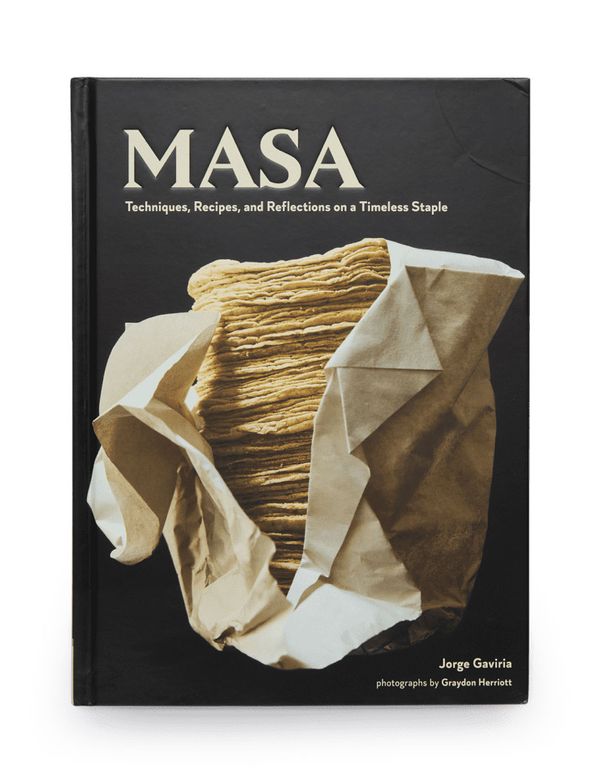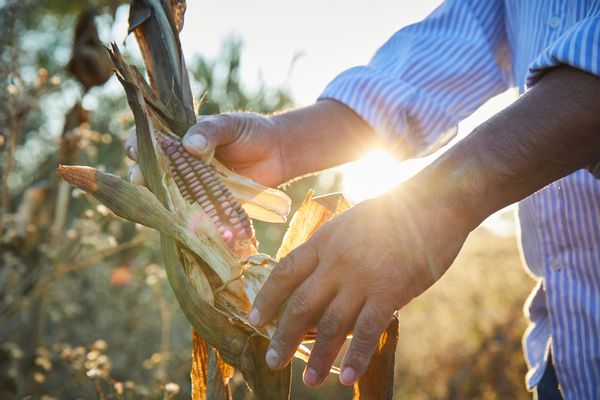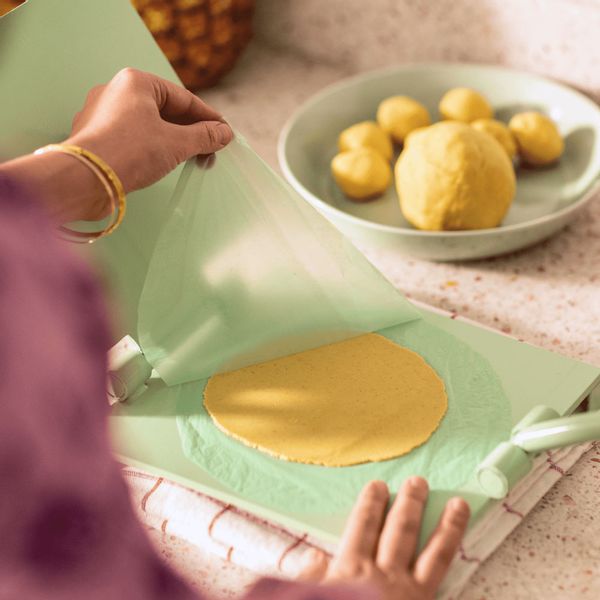
For some, a tortilla is a easy convenience. You grab a bag from the store, pop it open, use a tortilla or two as your taco vessel — and that's it. The focus may be on the taco filling, the garnish, the salsa, the guacamole, with very little thought going into the tortilla itself.
But for others, tortillas represent a lot more, tethering families to previous generations, as well as to the land that sustained them.
In order to better ascertain the true depth of masa harina and tortillas at large, Salon Food spoke with Jorge Gaviria, author of "MASA: Techniques, Recipes and Reflections on a Timeless Staple" and the founder of Masienda, otherwise known as the "better masa company." Here, Gaviria tells us why.

What exactly is heirloom masa?
Let's start with the second word. Masa is the Spanish word for dough. In this case, we are referring to dough made from freshly ground nixtamalized corn or hominy. Nixtamalization is the ancient process of cooking corn in a mixture of alkali (like slaked lime or wood ash) and water.
When fresh masa is dehydrated and ground into a fine flour, it's called masa harina, or 'dough flour,' which is the just-add-water ingredient many cooks use for making tortillas at home if they don't have access to fresh masa.
Next, heirloom. Until Masienda came around, most of the masa harina on the market was made from low-quality, genetically modified commodity field corn. When we talk about the heirloom corn that we sell (both in whole-kernel form and masa harina), we are referring to corn that comes from farmer-preserved seeds that have been hand selected for the best flavor and maintained for hundreds (even thousands) of years. These seeds are 100% farmer owned and exist outside of the large-scale value chains that we associate with the hybrid corn grown in the U.S.
What does corn mean to you? Was it integral to your upbringing?
I grew up in Miami, where so many Latinx communities converge, so corn — and masa specifically — was an elemental part of my diet. It was weekend carnitas tacos, hallacas around Christmas time, toaster-oven tostadas after school and so much in between. What I didn't know at the time was that much of the masa I was eating did not live up to its highest potential.
It wasn't until a trip to Oaxaca in 2014 that I experienced the real thing for the first time, by way of a humble tortilla.
At its simplest, what is a tortilla?
A tortilla is, simply put, a perfect food. It can be used as a utensil, a wrapper, or the starting point for many delicious preparations. A good tortilla, made fresh and hot off the comal, needs nothing more than a sprinkle of salt to be enjoyed.
How would you define equitable farming?
We have built an equitable model for farming (and production) that is a win-win for everyone. Our customers win because our corn and masa are delicious. But our farmers and their communities also benefit because we are creating long-term economic stability while reviving and preserving access to heirloom corn varietals that are crucial to Mexico's biodiversity.

What is Masienda? What is its mission statement and general ethos? What inspired you to create it?
Masienda is the better masa company. A combination of the words masa and tienda (store), Masienda is the masa purveyor of our generation, for our generation. We proudly partner with traditional farmers throughout Mexico to create a more equitable, sustainable and delicious model for sourcing heirloom corn. Bringing together heritage foods, a sustainable supply chain and inspiring content under one roof, Masienda is redefining what it means to be a 21st century food brand.
I was inspired to create Masienda while apprenticing at Blue Hill in New York. I was so energized by the ethos of the farm-to-table movement, but began to wonder why the same principles weren't being applied to the staple most elemental to what amounts to a large part of the U.S. population — corn. Thus began my journey to find a better tortilla, which led me to the Central Valleys of Oaxaca, the heartland of Mexico's maíz criollo (heirloom corn). That first bite of a tortilla was transformative and I knew I had to find a way to bring that experience to customers in the US.
How does terroir factor into corn, masa, tortillas, etcetera?
Corn is a plant and therefore an expression of the ecosystem that gives it life. It has terroir just as grapes in France and coffee in Ethiopia, for example. In large-scale, commodity agriculture, inputs like fertilizers and pesticides overpower the naturally-occurring expressions of the soil and surrounding ecosystem, which compromises the flavor and terroir, in turn.
By contrast, in the case of regenerative agriculture, the nuances of soil composition, climate, plant and animal diversity are front and center. Each variable conspires to create a wide range of expressions in flavor, texture and color of the raw ingredient (corn) and the finished product (masa). So, if you were to travel to different regions across Mexico, you'd notice that each tortilla looks and tastes a bit different from one another. This is a reflection of the terroir and the traditions that have grown from it.
What gave you the idea or inspiration to write MASA?
After almost a decade of working with masa, I just couldn't believe that there had yet to be a book written about the subject. Masa makes up a multi-billion dollar industry in the U.S. alone, it is as global of a staple as bread or rice or coffee and yet there were no dedicated literary resources to it; it has solely existed as an oral tradition for millennia. After connecting with hundreds and thousands of folks throughout the masa value chain, I realized I had developed a unique perspective to connect the dots and share this collective story with as many people as possible. That led to MASA: Techniques, Recipes and Reflections on a Timeless Staple.
Who were some of the collaborators you worked with to produce MASA?
I worked with a range of collaborators, from food scientists and historians to tortilla artisans and tortilleria owners, as well as contributing chefs like Carlos Salgado, Daniela Soto-Ines, Sean Brock and Alex Stupak.

We currently work across six states in Mexico, with a network of over 2,000 farmers who have preserved and improved their corn through natural selection over hundreds of years. They farm different varietals with different colors and characteristics, from blue cónico to bolita belove, pink xokoyul to yellow tuxpeño. Our role is not to dictate what is grown, but rather to open up market opportunities for those who would otherwise lack options for their available surpluses.
Many of these farmers grow heirloom varietals exclusively for the consumption of their own communities or families. And in order to preserve community access to heirloom corn, we only buy surplus inventory. Our pricing model and supply chain have been designed so as not to destabilize local markets, which are fundamental to the social, economic and nutritional well-being of these communities. We also guarantee advance payment to farmers in order to limit their exposure to risk, freeing them to further invest in their next planting cycle and balance their interests accordingly. The risk is thereby transferred to us/Masienda, who holds the inventory until we are able to sell it (or not sell, in which case it may become a loss). With almost ten years in the business, I take a lot of pride in seeing the trust we have established in communities and our ability to consistently show up for them, year after year.
What do you think should be more widely known about corn, masa, tortillas, Mexican and Latin cuisine in general?
Well, the long version of this answer is essentially the book I wrote, Masa. The short version is that a tortilla — a good one at least — is an exquisite thing. It's easy to be distracted by the taste: faintly sweet, a bit earthy, thoroughly wholesome. But also, we shouldn't forget the role that nixtamalized corn (in the shape of tortillas, tamales, sopes, tlayudas, etcetera) is also the reason why civilization in the Americas thrived for thousands of years. Masa has literally shaped our history.

What is "The Masa Map?"
The Masa Map is our directory of the growing movement of folks embracing masa in the U.S., that lives in the form of a Google Map on our website. It tracks noteworthy restaurants, taquerias, tortillerias, molinos and other establishments open to the public that are dedicated to either the traditional method of masa making (that is, the process of nixtamalizing corn) or show a commitment to heirloom corn. If you're looking for some of the best Mexican restaurants in America, chances are you'll find them here.

What would you most like to see for the future of masa?
I would love to see more people embracing masa making at home. With masa harina, making tortillas is easier than making bread and certainly faster too. As a parent, I delight in cooking alongside my daughter. While she's only three, she loves helping to make the masa (especially when we make a few different colors) and press it out into shapes. She takes so much pride in the tortillas she makes herself — but don't we all? Whether you're three or ninety three, there's something undeniably satisfying about making a perfect tortilla and taking that first bite.
Which recipes in MASA are you the proudest of? Which are your personal favorites?
Each recipe was selected because of how it says something new and dynamic about how masa can be used. I love all of the recipes we selected. I especially love the recipe for Lamb Birria with Masa Gnocchi from Gerardo Gonzalez, formerly of Lalito in NYC. It was so different, unexpected and yet totally familiar when I tried it for the first time at the restaurant.
I'm obsessed with salsa machas and the ones in the Masienda store sound amazing! Can you tell me about the production process for those?
The Pura Macha Salsa recipes were sort of a side-hustle, pandemic project, developed by myself and our COO Danielle Dahlin. They ultimately resonated so much with our customers that they became a permanent feature of Masienda. They are playful combinations on global flavors we really enjoy and can't get enough of. The cherry nib recipe is my current favorite — we subbed out nuts for cacao nibs, which give it an addictive texture. It's a sweeter recipe that pairs incredibly well with cheese (all kinds), quesadillas and braised meats. I can't get enough.
Is there anything else that you want to add?
If you have ever enjoyed a taco, do yourself a favor and make your next tortilla with masa harina at home. Not only does it take no time (5 minutes!), it will forever change your relationship with a food that you already know and love.







